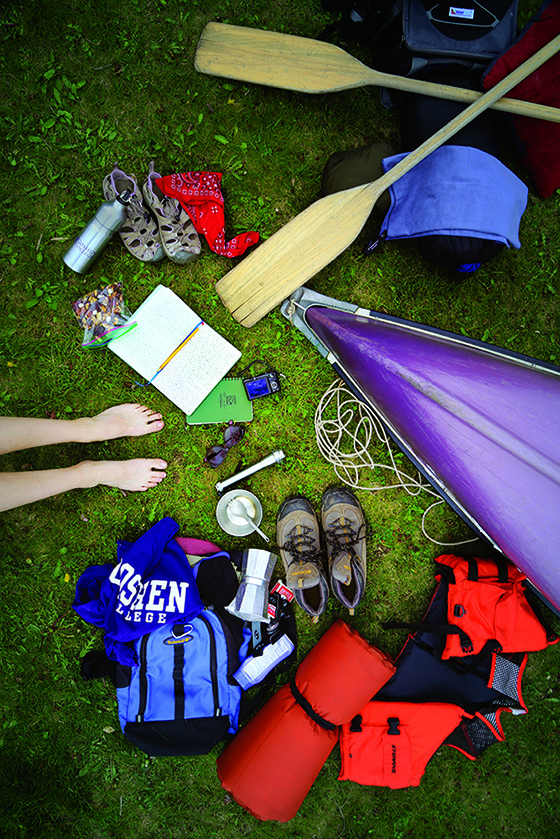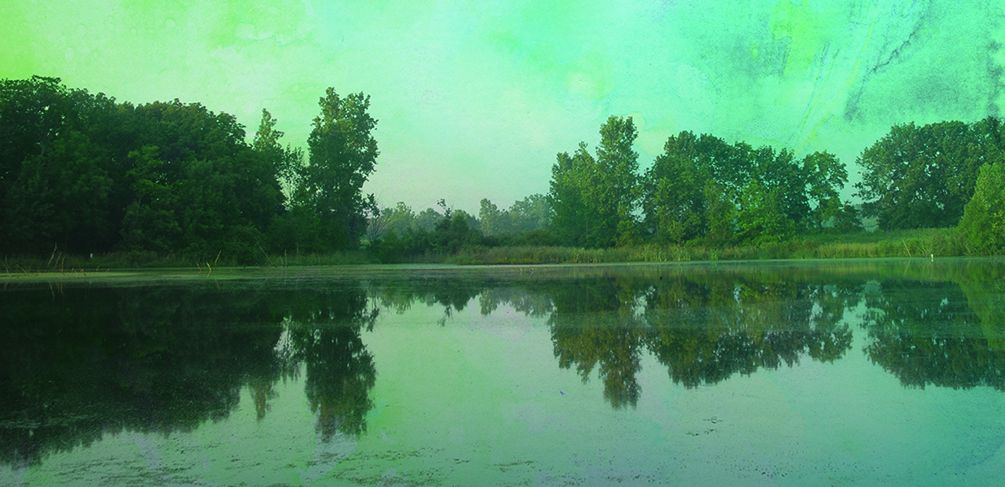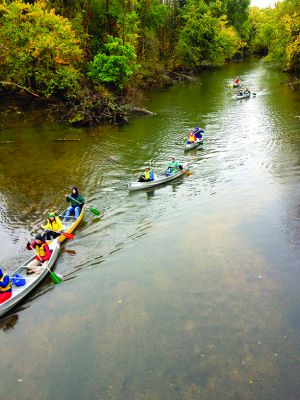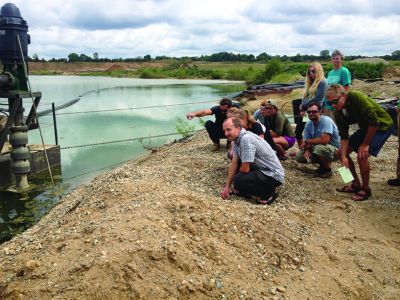Watershed Moments: The Sustainability Leadership Semester
By Jonathon Schramm
Associate Professor of Sustainability And Environmental Education
Journal excerpts by a 2015 SLS participant
“I am always taken back to the canoe trip when we stood in the center of the river and it was really hard, then we let the water move us and it was really easy. We need to remember that when thinking about controlling the environment.” (9.21.15)
Water, and the experience of it, forms part of the backbone of Goshen College’s Sustainability Leadership Semester (SLS), based at Merry Lea Environmental Learning Center each fall. From the placid waters of Kesling Wetland near the student cottages at Rieth Village, echoing with the calls of frogs and waterfowl, to the swift waters of the St. Joseph River, emptying into the expanse of Lake Michigan, SLS students are never far from water. Working to understand how water interacts with biological and social systems in our landscape becomes a gateway to broader discussions about the connections between humans and the environment of which we are a part. And just as water crosses human boundaries freely, students quickly realize that sustainability challenges require thinking across disciplines and other barriers that often prevent people from working together.
“[The] questions are very helpful in giving me a starting point for interviews… a really important skill that I have yet to master. There are definite dynamics that come into play that I hope this semester and project will start teaching me. Within all the fields I am interested in, I find that being able to relate to people and carefully find information is vital…” (9.14.15)
Students begin this journey with a 10-day orientation to Merry Lea, to life in community (since they live together at Rieth Village) and to the various academic threads that will guide their work (limnology, environmental policy, faith, ethics, sociology and economics) during a period we call Headwaters. This time includes such diverse activities as dipping for wetland invertebrates and reflecting on God’s care as seen in the structure of wildflowers, to beginning to analyze complex socio-ecological problems and learning how to cook using herbs gathered from the kitchen garden. Students begin to build bonds with each other, with the faculty and staff in the program, and with the land and its other inhabitants. And they begin to ask some intriguing questions!
“It is interesting to look back into our folklore and see how the idea that deep, dark swamps are bad is still being told in things like fairy tales. How can we change our stories to reflect our new understanding [that wetlands are incredibly valuable both ecologically and socially]?” (9.17.15)
Downstream
After getting a firm grounding in the place they’re starting at, the SLS crew moves into a nine-day and 60-mile canoe trip through their watershed, down the Elkhart and eventually St. Joseph Rivers, ending at Lake Michigan (we call this the Downstream Trip). Students have conversations with a wide variety of stakeholders along the way, from a pastor whose church uses the river for baptisms to the sustainability coordinators for the city of South Bend to small business operators and many others, all in the interest of learning how people understand their lives and work in relationship to the natural world around them. This trip offers a firsthand opportunity to learn why the environment is often a thorny area in public policy debates – although we all depend on it, we perceive that dependence in very different ways:
“I really appreciate Dave [Ostergren’s, director of the graduate program in environmental education,] answer to this question [of the definition of environmental policy]. I often find problems with the policy process, but it does have its time and place. While I think Dave is a bit gung-ho about it, I appreciate the wrestling we will do.” (9.17.15)
This journey is full of great memories and provides many ideas and concepts that continue to come up in conversations across the rest of the semester. And even a week of sleeping in tents is easy when your muscles are tired from full days of canoeing!
After the canoe trip, students return to Merry Lea for the heart of the semester at Rieth Village, home of Indiana’s first LEED Platinum-certified buildings, where they live, eat and learn together in a “living classroom.”
In a semester, students visit more than 60 different sites around the region and speak with as many as 130 different professionals. They are studying in four interrelated content courses and beginning their shared work on an applied project for the capstone course that connects them to nearby community organizations to help those groups develop a variety of projects. The learning community that was built through shared Headwaters and Downstream experiences continues, though, with several faculty present in almost all class sessions, bouncing ideas off each other and the students, and weekly field trips that continue the practice of learning from the broader community. The group grapples with the best strategies for engaging different social groups in sustainability questions:
“On how best to influence others towards sustainability (spend more time explaining “Why” than “What”): “This is something I need to think about more. The ‘why’ explains to people my values, core to me, so much so that the rest doesn’t matter as much. People can relate… because of the shared story in ‘why.’” (10.27.15)
And how to envision larger and smaller parts of our society working together on shared solutions in equitable ways:
“The bees (smaller, locally-based organizations) and the trees (larger, centralized institutions) are definitely something I need to incorporate into my thinking. Normally I write off the trees because of their slow movement, but our society has them and we all rely on them so they need to be included in the process… although rarely are they safe spaces. Work with them, not for them.” (10.30.15)
Applied Projects
During the final three weeks or so of the semester, students work exclusively with their partner organizations to complete their project work with them, presenting their final work just a few days before the semester ends. Projects in the most recent semester included collaborations with MDC-Goldenrod (a local organization serving adults and children with developmental and intellectual disabilities) to design multiple uses for a farm property that they are planning to develop into a programming site; conversations bringing together Greencroft retirement community residents and business owners to improve environmental quality in south Goshen; and planning with the Goshen Historical Society and the City of Goshen to survey a variety of city residents on their appreciation of and hopes for the Millrace Canal and Trail, a crucial recreational resource in the city. Since the students are working on different projects with different partner groups, this time is still rich with learning as the students talk with each other about their projects, discuss pieces that are going well and those that might not be.
Estuary Days
A final short-but-significant piece of the experience is a three-day Estuary Time, when all of the assignments have been turned in and students have the space to reflect – individually and as a group – on their learning over the semester. The outcomes are as varied as the students themselves, but it is not unusual for new understandings of place and one’s role in it to be clarified for many students:
“Defining home has always been a challenge for me… I like to define home as where I feel safe and wanted by the community around me. Intergenerational relationships are also important for a community and key for me to grow and learn.” (10.22.15)
Once the journal has been closed for the last time, the last call of Canada geese over the wetland has been heard and the last meal of the semester has been shared together at Rieth Village, another round of the SLS finishes. But the connections that have been forged between people, and between people and places, will long outlast that time, helping graduates of the experience to lead and serve their neighbors in whichever watersheds they call home in the future.








